Warning: This blog post contains some graphic images.
MLK day is day when we appropiately focus a lot on the Reverend Dr. Martin Luther King Jr.’s Christianity and the prophetic witness of the movement he led against racism and white supremacy.
We sometimes forget that most of the white people who Dr. King challenged were Christians. I think it is as important for me as a white person to understand the faith of the segregationists as it is to understand Dr. King’s faith. This is one way I can do my work and understand whiteness in the work of anti-racism.
Let’s start by taking one step back and looking at slaveholder Christianity. Specifically, the faith of white Christians who owned African-American slaves here in the United States. I’ll be drawing heavily on the first chapter of The Black Christ by Kelly Brown Douglas. You can read the whole chapter here.
Christian slaveholders were known to be crueler to their slaves then non-Christians. In chapter 10 of Frederick Douglass’s autobiography, The Narrative of the Life of Frederick Douglass he wrote:
Were I to be again reduced to the chains of slavery, next to that enslavement, I should regard being the slave of a religious master the greatest calamity that could befall me. For of all slaveholders with whom I have ever met, religious slaveholders are the worst. I have ever found them the meanest and basest, the most cruel and cowardly, of all others. It was my unhappy lot not only to belong to a religious slaveholder, but to live in a community of such religionists. Very near Mr. Freeland lived the Rev. Daniel Weeden, and in the same neighborhood lived the Rev. Rigby Hopkins. These were members and ministers in the Reformed Methodist Church.
What’s going on here? Why in the world are Christians worse slave holders than non-Christians? Now it may be tempting for us today to say, “Oh, they weren’t really Christians,” but I’m afraid that’s too easy an out. Their Christian tradition still shapes our tradition today.
African-American theologian Kelly Brown Douglas points out two characteristics of slave-holding Christianity:
First, after a person is converted to belief in Jesus as Christ, his or her salvation is automatic… this freed many slaveholders to do whatever they deemed necessary to keep their slaves under control.
…
Second, because Jesus ministry is ignored, his liberating actions do not become a standard for Christian actions… The Christian feels no obligation to treat others, especially the oppressed, the way Jesus treated them. Again, enslavers are free to be as cruel as they want towards a slave, while being assured salvation.
(Black Christ, p. 18-19)
In other words, in order to integrate their faith with their owning of slaves, slave owners spiritualized Jesus. White supremacist Christianity has nothing to do with your material conditions. Brown-Douglas quotes the Edmund Gibson, Bishop of London in the 18th century, laying it out very clearly:
The Freedom which Christianity gives, is a Freedom from the Bondage of Sin and Satan, and from the Dominion of Men’s Lust and Passions and inordinate Desires; but as to their outward Condition, whatever that was before, whether bond or free, their being baptized and becoming Christians, makes no matter of Change in it.
The Bishop was quoted in this Proslavery Petition, November 10, 1785 to the General Assembly of Virginia from the “Free Inhabitants of Halifax County.”
Unfortunately, these values didn’t go away at the end of the civil war. Between 1919 and 1939, according to Robert Moats Miller, white people in the United States “hung, shot, burned, gouged, flogged, drowned, impaled, dismembered, garroted, and blowtorched” to to death more than 500 black people in lynchings. (from the The Protestant Churches and Lynching, 1919-1939, The Journal of Negro History, pp. 118-131)
This lynching happened In Marion, Indiana in 1930, two hours from where I grew up in Goshen. 2,000 people participated in this lynching. The names of the black men in this photo are Thomas Shipp and Abram Smith. A third man, James Cameron escaped at the last minute and lived until 2006.
Because of how disturbing the images of Thomas and Abram are, we often miss the smiling faces of the white people in these images:
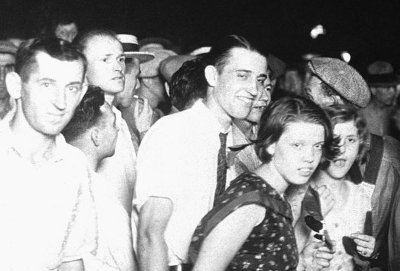
What is behind these smiles? A presentation by Dr. Joy DeGruy first drew my attention to these smiling faces and during a presentation she did at the annual White Privilege Conference in 2010. She pointed out the deep sickness of white supremacy and it’s symptom of dehumanization of black and white people that made these smiles possible.
It might be easy for us to say, “Oh, those people weren’t Christians.” But that’s too easy. Yes, these are sinners, but so are we. Walter White was an anti-lynching activist and president of the NAACP during this period. He said: “It is exceedingly doubtful that lynching could possibly exist under any religion than Christianity” – (quoted in Amy Louise Wood, “Lynching and Spectacle” , p. 50)
This lynching happened In Omaha, Nebraska in 1919. And 4,000 people participated in the riot aimed at lynching this man, Will Brown. The riot is chronicled in harrowing hour by hour detail on Wikipedia.
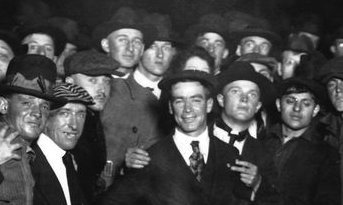
Again we have the smiling faces.
Dr. James Cone in his presentation, “Strange Fruit: The Cross and the Lynching Tree” (video here) points out that these weren’t just random acts of violence. Rather, they worked like Crucifixions. Crucifixions were set up to keep Roman slaves and poor people from political revolt. In the same way, lynchings were meant to keep black people in their place: that is subject to white control and oppression.
30 years later this same bigotry was on display in reaction to the lunch counter sit ins. This photos is from the a 1963 sit in at a Woolworth lunch counter in Jackson, Mississippi.
While overt bigotry like this is not acceptable today in the way it was then, but that sickness behind those white smiles at the lynching do not go away so easily. They haven’t disappeared as cleanly as we would like to believe.
For example, In the 5 years I’ve lived here near the corner of Pratt and Ashland, it’s become really clear how disrespected the black and Latino kids who hang out on this corner are. I’ve seen police officers call them animals. When I suggested to the officer that this wasn’t appropriate, he told me I didn’t really know them. While this officer happened to be more honest than most, it becomes pretty clear that this is the view held by most officers.
Four years ago, I wrote here about watching an officer sit in hiscar and watch as two black kids fought each other. When I asked him why, he said he was worried they’d grab his gun. Would he have acted the same way if I as a white person were being attacked? This officer was smart enough not to wear his racism on his leave, but the results are the same.
It would be easy for me to see this problem as one limited to jaded police officers who have been soaked in the racist atmosphere of the Chicago Police department. But unfortunately, the problem goes deeper than that. Indeed it such a critical issue, that Mennonite Church USA had anti-racism as one of its four vision and goals from 2000-2010.
We in the US Church today, need to consider slaveholder and segregationist Christianity as we read the bible. Next week I’ll share about how this lens affects how I read the Beatitudes and some practical things ways it helps me to think about how I can be an ally to oppressed people.
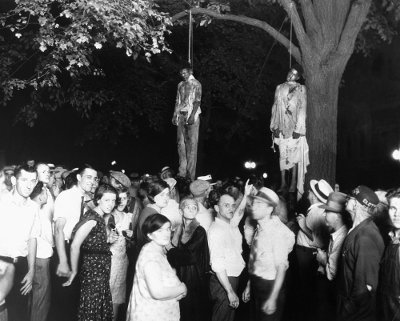
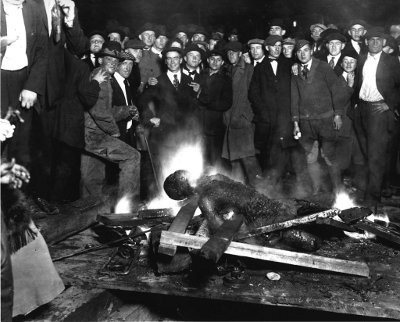
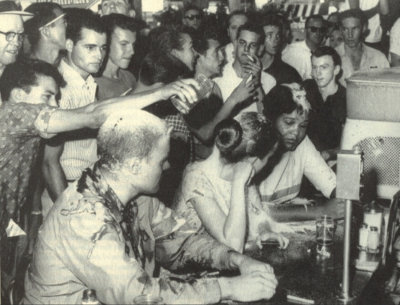
Pingback: Martin Luther King and the Quest for a Just Society « Exploring Our Matrix
Pingback: Pass the Toothpicks: Becoming an Ally with the Beatitudes » Young Anabaptist Radicals
Lynching was not only done to “black” people. As with tarring and feathering it was a form of mob vengeance…your claim of the primary purpose for crucifixions is also shortsighted…it was also used outside of the Roman Empire and used on a variety of people determined to be criminals by authorities. who were those two guys beside Jesus again?
Overall, I think you bring up a good discussion point….how to deal with those that come to the Body of Christ and yet have beliefs, identities, loyalties, etc. that are determined to be outside of the Body of Christ….how to loving find a way to interact with people while also preventing the church from becoming a political tool of outside groups.
1 John 4:20: “If someone says, “I love God,” and hates his brother, he is a liar; for he who does not love his brother whom he has seen, how can[a] he love God whom he has not seen?”
The Scriptures clearly teach that anyone who harbors hatred in his/her heart toward another person (in context, this is not just about another Christian or a family member) is NOT A CHRISTIAN because they cannot possibly say they love God, and hate others.
Those “smiling” faces come in all colors and shades of skin pigmentation.
And, “only under Christianity is lynching possible”???? Are you kidding me??? That’s a flat out lie!
Anyone who does such things or participates in such things is NOT a believer. They may verbally say the right things, but obviously their heart is FAR, FAR, FAR from God’s.
Yes, Christians are still sinners and can still sin, but as Jesus also said in Matthew 7:21, “Not everyone who says ‘Lord, Lord’, shall enter the kingdom of Heaven, but only he who does the will of my Father.”
Aside from the harrowing photos displayed in the blog post, I found it most shocking that the author would suggest that it is too easy to say that these people were not Christian. The people who were involved in these lynchings, and smiling thereof, were NOT CHRISTIANS. On this side of eternity, Christ followers are sinners and struggle with their sin nature. Thus, we must do battle with sin, through the power of the Holy Spirit, in daily submission to God. This is a far cry from ongoing, perpetual, willful, calculated, systematic, violent oppression that dehumanizes and murders those created in the image of God. Frederick Douglass drives this home in both Narrative and My Bondage and My Freedom.
Was the rich man “who was clothed in purple and fine linen and fared sumptuously every day” who ignored the “beggar named Lazarus, full of sores, who was laid at his gate, desiring to be fed with the crumbs which fell from the rich man’s table” (Luke 16:19-31) just a sinner? Indeed he was a sinner, but one who clearly did not know God. Considering the outcome of the rich man, what would be the end of those people in the photos if they did not repent and believe in Jesus?
The people in the photos capture America’s lasting and vile legacy of not just oppression, but violent oppression of whites toward blacks.
For the love of our Lord Jesus Christ, and for the glory of His most holy name, please carefully think through what you are saying.
Kyrie eleison.